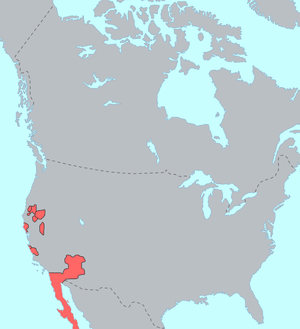Hokan languages
| Hokan | |
|---|---|
| (controversial) | |
| Geographic distribution | North America |
| Linguistic classification | Proposed language family |
| Subdivisions | |
| ISO 639-5 | hok |
| Glottolog | None |
|
Hokan families of California | |
The Hokan /ˈhoʊkæn/ language family is a hypothetical grouping of a dozen small language families that were spoken mainly in California, Arizona and Baja California. In nearly a century since Edward Sapir first proposed the "Hokan" hypothesis, little additional evidence has been found that these families were related to each other. Although some Hokan families may indeed be related, especially in northern California, few linguists today expect Hokan as a whole to prove to be valid .
The name Hokan is loosely based on the word for "two" in the various Hokan languages: *xwak in Proto-Yuman, c-oocj (pronounced [koːkx]) in Seri, ha'k in Achumawi, etc.
Geographic distribution of the Hokan languages suggests that they became separated around the great central valley of California by the influx of later-arriving Penutian and other peoples; archaeological evidence for this is summarized in Chase-Dunn & Mann (1998). These languages are spoken by Native American communities around and east of Mount Shasta, others near Lake Tahoe, the Pomo on the California coast, and the Yuman peoples along the lower Colorado River. Some linguists also include Chumash, between San Francisco and Los Angeles, and other families, but the evidence is insubstantial, and most now restrict Hokan to some or all of the languages listed below.
The Yurumanguí language of Colombia was claimed to be Hokan by Rivet.[1] This claim has not been accepted by historical linguists.
Languages
The Hokan languages retained by Kaufman (1988) due to regular sound correspondences and common core vocabulary are as follows. (The data on which these conclusions were drawn have not been published or evaluated by anyone else.) Apart from Shasta–Palaihnihan and Yuman, all branches are single languages or shallow families.[2]
- Chimariko
- Yana/Yahi
- Karuk
- Shasta–Palaihnihan
- Shastan (4)
- Palaihnihan (2)
- Pomoan (7)
- Washo
- Esselen
- Salinan
- Yuman (12)
- Seri
- Coahuilteco
- Comecrudan (3)
- Tequistlatecan (3)
- Jicaquean (Tolan, 2)
Marlett (2008) reevaluated the evidence and concluded that the evidence for Seri and Salinan has not been systematically or convincingly presented. The inclusion of the Tequistlatecan languages has also not received much support. The Chumash languages were once included, but that position has been almost universally abandoned.
See also
Line notes
Sources
- Bright, William (1956). "Glottochronologic counts of Hokaltecan materials". Language. 32 (1): 42–48. JSTOR 410651. doi:10.2307/410651.
- Campbell, Lyle (1997). American Indian languages: the historical linguistics of Native America. Oxford: Oxford University Press.
- Chase-Dunn, Christopher; Kelly M. Mann (1998). The Wintu and Their Neighbors: A Small World-System in Northern California. Tucson: University of Arizona Press.
- Golla, Victor. (2011). California Indian Languages. Berkeley: University of California Press. ISBN 978-0-5202-6667-4
- Kaufman, Terrence. 1988. "A Research Program for Reconstructing Proto-Hokan: First Gropings." In Scott DeLancey, ed. Papers from the 1988 Hokan–Penutian Languages Workshop, pp. 50–168. Eugene, Oregon: Department of Linguistics, University of Oregon. (University of Oregon Papers in Linguistics. Publications of the Center for Amerindian Linguistics and Ethnography 1.)
- Marlett, Stephen A. 2007. Las relaciones entre las lenguas “hokanas” en México: ¿Cuál es la evidencia?. In Cristina Buenrostro & others (eds.), Memorias del III Coloquio Internacional de Lingüística Mauricio Swadesh, 165-192. Mexico City: Universidad Nacional Autónoma de México & Instituto Nacional de Lenguas Indígenas.
- Marlett, Stephen A. 2008. The Seri and Salinan connection revisited. International Journal of American Linguistics 74.3: 393–99.
- Rivet, Paul (1942). "Un dialecte Hoka Colombien: le Yurumangí". Journal de la Société des Américanistes de Paris. 34: 1–59. doi:10.3406/jsa.1942.2334.
- C. Michael Hogan (2008) Ring Mountain, The Megalithic Portal, ed. Andy Burnham
- Greg White and Mark Basgal. 1993. There Grows a Green Tree: Papers in Honor of David A. Fredrickson, Center for Archaeological Research at Davis, Center for Archaeological Research at Davis Davis, Calif., 423 pages ISBN 1-883019-12-5, ISBN 978-1-883019-12-9
External links
- (in Spanish) (PDF) Las relaciones entre las lenguas “hokanas” en México: ¿Cuál es la evidencia? (prepublication version)
- (in English) Vocabulary Words in the Hokan Language Family
